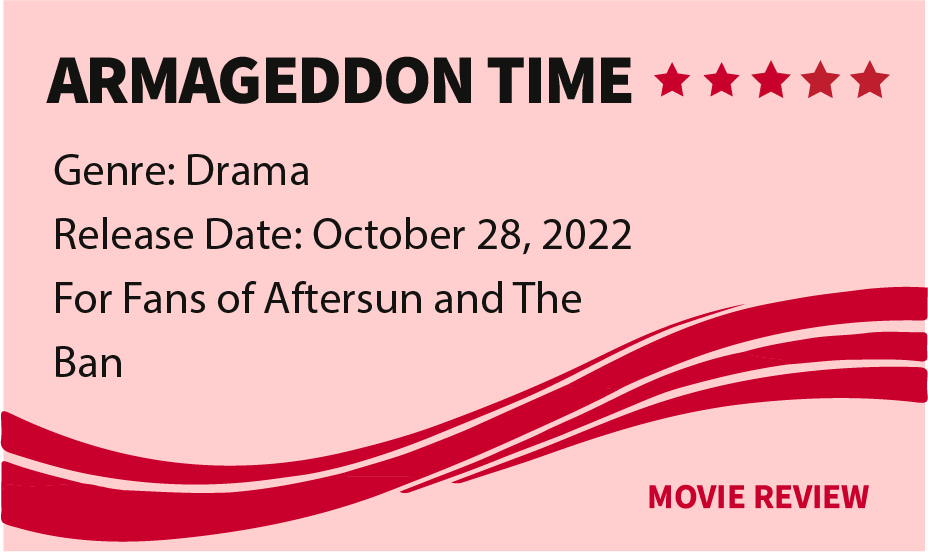In ‘Armageddon Time,’ James Gray’s past mirrors the present

For many, their childhood memories may not be fully crystalline, but the emotions attached to these memories are ever present.
It is astonishing that, far beyond his adolescence, director James Gray still remembers a searing amount of detail and clarity in his own childhood memories. In his film-grained semi-autobiographical drama “Armageddon Time,” Gray captures these images with both period-specific accuracy and a lens of personal introspection and accountability.
The personal screen memoir meditates on white privilege and racial prejudice in pre-Reagan America, told through the eyes of 12-year-old Paul Graff (Banks Repeta), Gray’s fictional counterpart, as he grows up in Queens, N.Y. in 1980 with his parents (Anne Hathaway and Jeremy Strong), his brother (Ryan Sell) and his multi-generational Jewish relatives (led by Anthony Hopkins).
Paul is friends with his Black schoolmate, Johnny (Jaylin Webb), with whom he bonds over their dreams — Paul aspires to be an artist and Johnny dreams of moving to Florida to work for NASA. They enjoy being class clowns together, but Johnny receives harsher discouragement and punishment for his actions from their school teacher than Paul does. When Paul’s parents switch him to a preparatory academy helmed by Maryanne Trump (Jessica Chastain) after an incident involving him and Johnny, their friendship is put to the test. As Paul is thrust into a sphere of heightened privilege and is told by his parents to no longer associate with Johnny, he begins to recognize the injustices that exist in the systems that benefit him and faces the decision to assimilate or resist the status quo.
At first, the film comes across as a warm, aging deck of photographs and slides thanks to its cozy production design utilizing warm autumnal hues and the aesthetics of early 1980’s East Coast prep. Yet, its stylistic details come to both contrast with and complement the coldness of its thematic truth and achieve a cinematic harmony that captures everything Gray has felt. Instead of reveling in a story of what could very easily be a nostalgia-coated portrait of his childhood, Gray questions everything he once knew as a young boy and invites us to examine both his own past mistakes and the United States’ previous, and relevant, failings of minorities.
The family scenes are some of the film’s most memorable, featuring standout supporting performances from Strong and Hathaway that are as hilarious just as they are terrifying from a child’s perspective. Gray figuratively opens the doors of Paul’s childhood home to his audience and welcomes them in to witness slices of his life: family dinner gatherings, political banter in front of the television and tales of Jewish relatives who immigrated to America. But Gray also looks beyond the world of his middle-class New York suburb to examine the promises of the American Dream. Paul’s wise and empathetic grandfather Aaron, played by Hopkins in a lovely performance, narrates the histories of anti-Semitism in Europe and stories of his own relatives through bedtime stories.
What must not go unnoticed are the leading performances of Banks and Webb, incredible young talents whose on screen friendship authentically captures the wide-eyed wonder of youth and the temptation of independence. Both actors portray the inherent innocence of childhood with captivating authenticity while simultaneously coping with the injustices of racism and complexities of class and privilege.
The eclectic selection of music is also a standout. It feels as if Gray had found an old box filled with his family’s record collection and curated it into the film’s groovy and punk soundtrack — from The Clash to The Sugarhill Gang, even featuring a piece from Tchaikovsky’s gracefully cinematic ‘Swan Lake.’ To complement the funky tones is an acoustic guitar score from Christopher Spelman that captures both the sentimentality of the past and Gray’s brutally reflective honesty and regret.
What makes “Armageddon Time” so effective is Gray playing out his nearly autobiographical story as it happened, sufficing nothing, and allows us to sit with what we saw. Yet with its themes of the hope of the American Dream — and how it may fail us — and the tragedy of systemic failure, it is evident that Gray hopes to encourage that we do our own reflecting.
“Armageddon Time” is soulfully encapsulating in its specificity of detail and simplicity of heart. It is nothing short of an emotionally moving experience, hitting all the right notes of the triumph of love and devastation of regret. Gray commands his story with a gravity of intimacy that feels almost voyeuristic on the viewer’s part, but welcomed with open arms, making for one of the most moving cinematic experiences of the year.
“Armageddon Time” opens in limited theaters Oct. 28 and will open nationwide Nov. 4.

